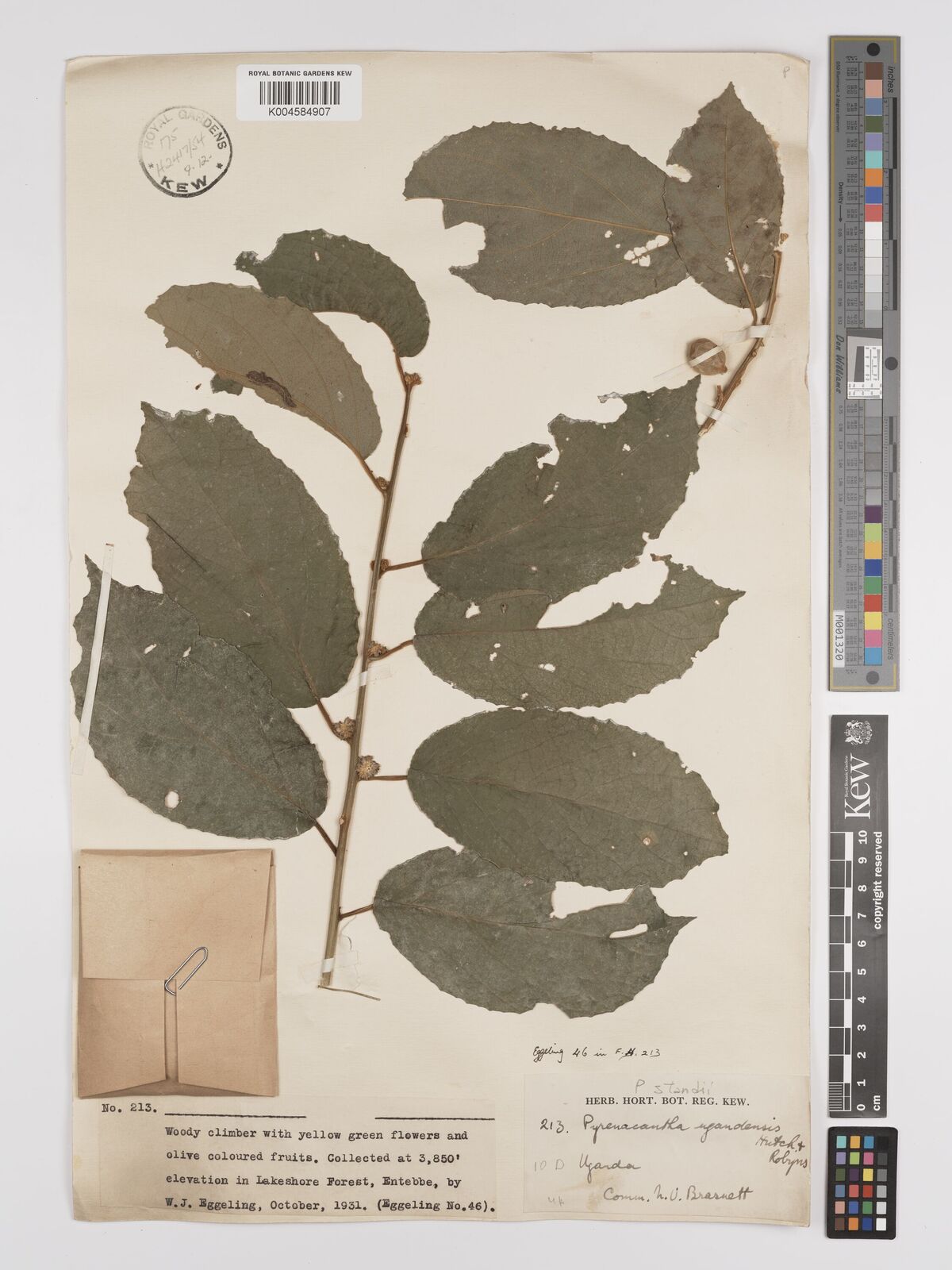Pyrenacantha staudtii

|
|
Pyrenacantha staudtii Common Names: Pyrenacantha, Spiny Icacin Scientific
Classification Kingdom: Plantae Phylum: Tracheophyta Class: Magnoliopsida Order: Aquifoliales Family: Icacinaceae Genus: Pyrenacantha Species: P. staudtii Synonyms: Icacina staudtii Engl., Pyrenacantha staudtii Engl. Morphological Description Pyrenacantha staudtii is a spiny evergreen shrub or small tree, typically 3–5 m
tall, occasionally reaching 6 m in dense forests. Its key features include: · Stem: Woody, armed with sharp, recurved spines (1–2 cm long),
grayish-brown bark · Leaves: Simple, alternate, elliptic to obovate, 5–12 cm long, 3–6 cm
wide, glossy dark green, with entire margins · Flowers: Small (3–5 mm), greenish-white, unisexual, borne in axillary
clusters or racemes, blooming during rainy seasons · Fruit: Globose drupes, 1–2 cm in diameter, turning red or orange
when ripe, fleshy, containing 1–2 seeds The plant’s spines and
glossy foliage make it distinctive in its habitat (Dalziel, 1948). Distribution and Habitat Pyrenacantha staudtii is native to tropical Africa, ranging from Nigeria,
Cameroon, Gabon, and the Republic of Congo to Uganda and Angola. It thrives in: · Ecosystems: Lowland rainforests, gallery forests, and secondary jungles
(altitude 0–1,200 m) · Soils: Moist, well-drained loams or sandy loams (pH 5.0–6.5) · Climate: High humidity (70–90%), temperatures of 22–30°C, and annual
rainfall of 1,500–3,000 mm It is often found in
shaded understories or forest edges (Awe et al., 2011). Ethnopharmacology Pyrenacantha staudtii , commonly known as African nutmeg or "Ilomba," is
a tropical tree native to West and Central Africa. Various parts of the tree,
particularly the bark, have been traditionally used to treat a range of health
conditions, including skin infections, coughs, chest complaints, anemia,
leprosy, and as a potent purgative. Scientific studies have corroborated
several of these traditional uses, demonstrating that extracts from P. angolensis possess antibacterial,
antiparasitic, anti-inflammatory, analgesic, and antihemorrhagic properties.
Additionally, the plant has been employed as an antidote against poisons, in
the management of hyperglycemia, and in addressing female infertility. Its
efficacy is attributed to a rich phytochemical composition, including tannins
and flavonoids, which contribute to its antimicrobial and antioxidant
activities, supporting its use in treating intestinal disorders like dysentery
and diarrhea. Furthermore, P. angolensis has shown potential in managing
diabetes, cognitive disorders, cancer, osteoarthritis, and in promoting wound
healing. · Anti-inflammatory: In Nigeria, leaf extracts reduced
carrageenan-induced paw edema in rats by 45% at 200 mg/kg, linked to flavonoids
(Akubue et al., 1983). · Wound Healing: Leaf poultices are applied in Cameroon; methanol extracts
showed antibacterial activity against Staphylococcus aureus (MIC 50 µg/mL) due to saponins (Awe et
al., 2011). · Gastrointestinal Issues: In Gabon, bark decoctions treat diarrhea;
aqueous extracts inhibited castor oil-induced diarrhea in mice by 60% at 400
mg/kg (Awe et al., 2011). · Respiratory Conditions: In Congo, root infusions relieve coughs;
no direct studies, but anti-inflammatory effects may support this use (Burkill,
1994). · Analgesic: research indicates that the aqueous leaf extract of P. staudtii exhibits significant,
dose-dependent analgesic effects in mice subjected to acetic acid-induced
writhing and formalin-induced paw licking tests. These findings suggest that
the plant's extract may exert its analgesic effects through both peripheral and
central mechanisms, potentially involving the inhibition of prostaglandin
synthesis and modulation of nociceptor activity. (Imieje et al., 2017). · Anticonvulsant: Studies have demonstrated that methanol
extracts of P. staudtii exhibit significant anticonvulsant effects in mice,
likely through interactions with the GABAergic and opioidergic systems (Wakeel
et al., 2020) Additionally, compounds such as bis(8-hydroxyl-2-methylnonyl)
phthalate and bis(8-methylnonyl) phthalate have been isolated from the plant,
which may contribute to its anticonvulsant activity (Oladoye et al., 2013). ⚠ Toxicity Profile: Oral LD₅₀ of leaf aqueous extract in mice is
2,155 ± 80 mg/kg, indicating moderate toxicity. High doses (>1,000 mg/kg)
may cause gastrointestinal distress (Awe et al., 2011). Additional Uses · Ornamental: Grown for its glossy leaves and colorful fruits in tropical
gardens. · Ecological: Spines deter herbivores, aiding forest understory stability
(Dalziel, 1948). · Cultural: Used in Nigerian rituals for protection due to its thorny
nature (Burkill, 1994). References
External Links More Pictures
|
|
| Compounds of Pyrenacantha staudtii |
|
| References |